Convention center
A convention center (American English; or conference centre in British English)[1] is a large building that is designed to hold a convention, where individuals and groups gather to promote and share common interests. Convention centers typically offer sufficient floor area to accommodate several thousand attendees. Very large venues, suitable for major trade shows, are sometimes known as exhibition halls. Convention centers typically have at least one auditorium and may also contain concert halls, lecture halls, meeting rooms, and conference rooms. Some large resort area hotels include a convention center.

Types
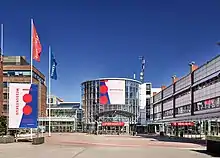
- Meeting facilities with lodging: hotels that include their own convention space in addition to accommodation and other related facilities, known as convention hotels.
- Meeting facilities without lodging: are convention centers that do not include accommodation; usually located adjacent to or near a hotel(s).[2]
- Other: any convention and meeting facilities designed to hold large numbers of people. Can exist alone (e.g., stadiums, arenas, parks, etc.) or within other structures (e.g., university lecture halls, museums, theaters). Usually do not include accommodation.[3]
History
The original convention centers or halls were in castles and palaces. Originally a hall in a castle would be designed to allow a large group of lords, knights and government officials to attend important meetings with the king. A more ancient tradition would have the king or lord decide disputes among his people. These administrative actions would be done in the great hall and would exhibit the wisdom of the king as judge to the general populace.
One of the most famous convention center debacles happened in France on June 20, 1789. King Louis XVI locked a group known as the Third Estate out of the meeting hall in Versailles. This led to the revolutionary group holding their meeting in an indoor tennis court. This was the first modern democratic conference center and lead to the Tennis Court Oath[4] and the French Revolution.
Some historic centers
19th-century exhibition halls
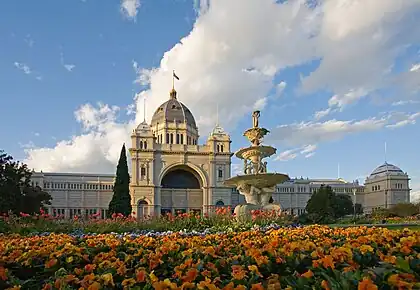
- 1850 Bingley Hall (destroyed by fire in 1984), Birmingham, England[5]
- 1851 The Crystal Palace (destroyed by fire in 1936), London, England
- 1855 Palais de l'Industrie (dismantled in 1897), Paris, France
- 1873 Alexandra Palace, London, England[6]
- 1876 Memorial Hall, Philadelphia, Pennsylvania
- 1878 Exhibition Place, Toronto
- 1878 La Rural, Buenos Aires, Argentina[7]
- 1878 Music Hall, Cincinnati, Ohio
- 1879 Garden Palace (destroyed by fire in 1882), Sydney, Australia
- 1880 Royal Exhibition Building, Melbourne, Australia
- 1898 Aberdeen Pavilion, Ottawa, Ontario
- 1898–1903 Beurs van Berlage, Amsterdam, Netherlands
20th-century exhibition halls
- 1900 Grand Palais, Paris, France
- 1909 Festhalle, Frankfurt, Germany
- 1955 McCormick Place, Chicago, Illinois
- 1958 Centre of New Industries and Technologies, Paris, France
- 1959 Las Vegas Convention Center, Las Vegas, Nevada
- 1974 Kenyatta International Convention Centre, Nairobi, Kenya
- 1975 Helsinki Fair Centre, Helsinki, Finland
- 1976 Georgia World Congress Center, Atlanta, Georgia
- 1979 Internationales Congress Centrum, Berlin, Germany
- 1981 Moscone Center, San Francisco, California
- 1983 Hong Kong Convention and Exhibition Centre, Hong Kong, China
- 1985 Tampere Fair Centre, Tampere, Finland[8]
- 1988 Washington State Convention Center, Seattle, Washington
- 1989 Taipei International Convention Center, Taipei, Taiwan
- 1990 Colorado Convention Center, Denver, Colorado
- 1993 Pennsylvania Convention Center, Philadelphia, Pennsylvania
- 1997 Tokyo International Forum, Tokyo, Japan
21st-century exhibition halls
- 2001 Bethlehem Convention Palace, Bethlehem
- 2003 Walter E. Washington Convention Center, Washington, D.C.
- 2008 BT Convention Centre, Liverpool, England
- 2008 Raleigh Convention Center, Raleigh, North Carolina
- 2012 Convention Center Poet Ronaldo Cunha Lima, João Pessoa, Brazil
- 2014 Kaohsiung Exhibition Center, Kaohsiung City, Taiwan
- 2017 AU Convention Center, Visakhapatnam, India
- 2021 Rudraksha Convention Center, Varanasi, India
Image gallery

 Exhibition Hall of the Makaryev Fair
Exhibition Hall of the Makaryev Fair Kongresshalle Berlin – House of the Cultures of the World
Kongresshalle Berlin – House of the Cultures of the World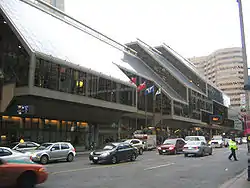
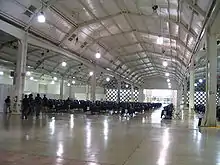
.JPG.webp) McCormick Place in Chicago, the largest Convention center in North America
McCormick Place in Chicago, the largest Convention center in North America
 The entrance to the Pirkkahalli sports arena at the Tampere Exhibition and Sports Centre in Tampere, Finland
The entrance to the Pirkkahalli sports arena at the Tampere Exhibition and Sports Centre in Tampere, Finland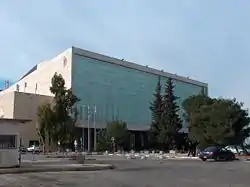
 View of the west portion of the San Diego Convention Center from West Harbor Drive. The San Diego Convention Center is one of the largest in North America and is home to Comic-Con International
View of the west portion of the San Diego Convention Center from West Harbor Drive. The San Diego Convention Center is one of the largest in North America and is home to Comic-Con International Pittsburgh's David L. Lawrence Convention Center, the first LEED-certified convention center in North America
Pittsburgh's David L. Lawrence Convention Center, the first LEED-certified convention center in North America
.jpg.webp)

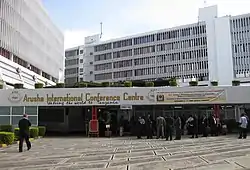
 Birchwood Conference Centre, Johannesburg
Birchwood Conference Centre, Johannesburg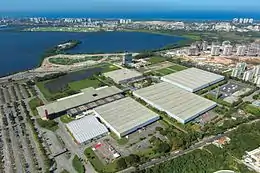 Riocentro convention center in Rio de Janeiro, the largest in Latin America, and also a 2016 Olympic venue
Riocentro convention center in Rio de Janeiro, the largest in Latin America, and also a 2016 Olympic venue
_(cropped).jpg.webp) The Terminal Auditorium, an early 20th century convention center in Toledo, Ohio
The Terminal Auditorium, an early 20th century convention center in Toledo, Ohio Congress center (Palais des Congrès) in Liège, Belgium
Congress center (Palais des Congrès) in Liège, Belgium
See also
References
- "English definition of "convention centre"". Cambridge Dictionaries Online. Retrieved 13 March 2015.
- Wood, Roy C.; Brotherton, Bob (2008). The SAGE Handbook of Hospitality Management. London: SAGE Publications Ltd. pp. 413–414. ISBN 978-1-4129-0025-6.
- Convention Industry Council (February 2011). The Economic Significance of Meeting to the U.S. Economy (Report). PwC.
- "Tennis Court Oath | Summary & Facts". Encyclopedia Britannica. Retrieved 2020-10-15.
- "The History of Conference Centers". Lane End Conference Center. 26 January 2015. Retrieved 13 March 2015.
- "Alexandra Palace, Muswell Hill and Wood Green, North London". The Victorian Web. Archived from the original on 23 July 2008. Retrieved 13 March 2015.
- "La Rural | Predio Ferial de Buenos Aires - Centro de Exposiciones, Congresos, Convenciones y Eventos". www.larural.com.ar (in Spanish). Archived from the original on 2015-07-27. Retrieved 2016-11-10.
- The story of Tampere Trade Fairs